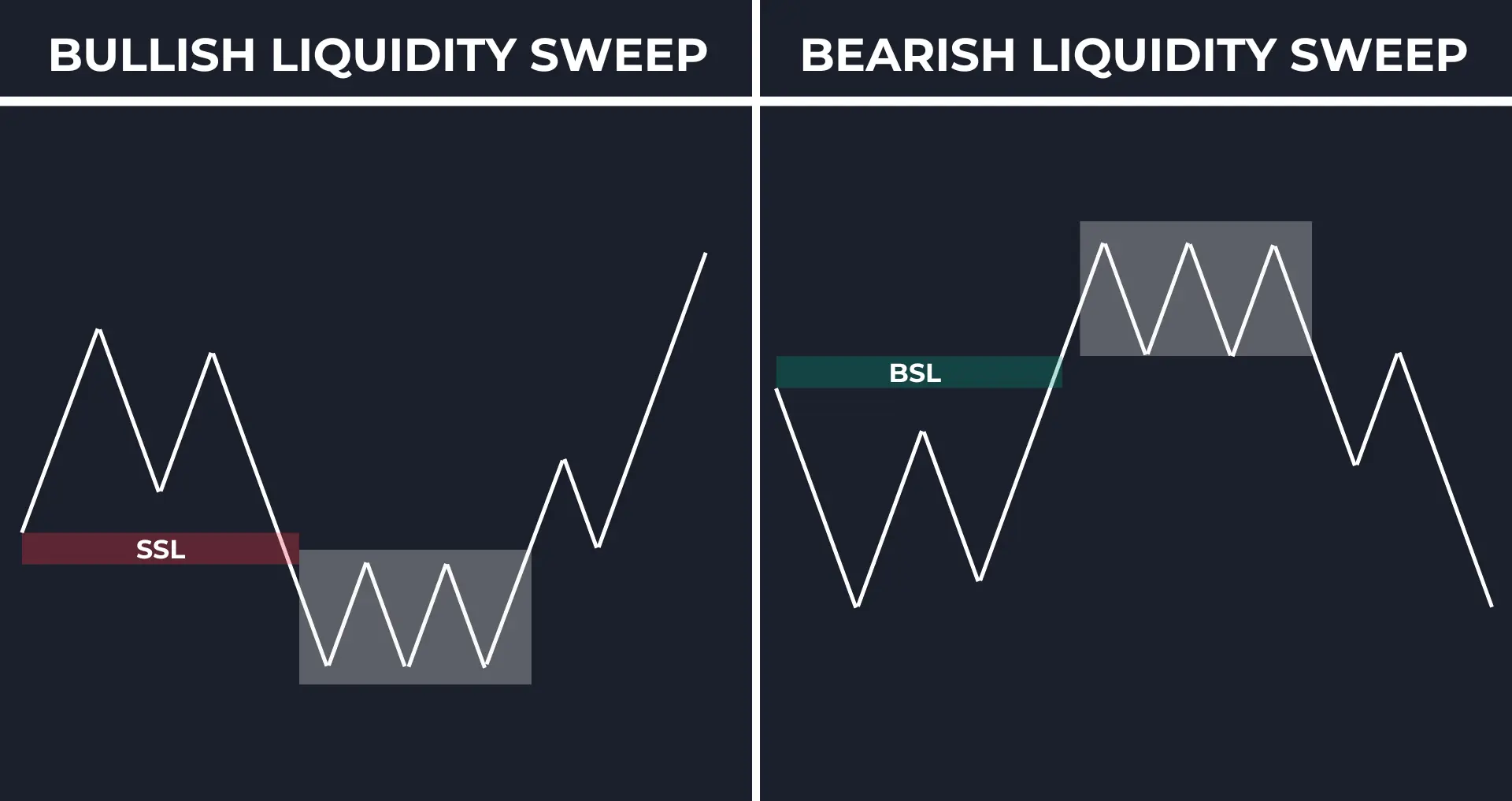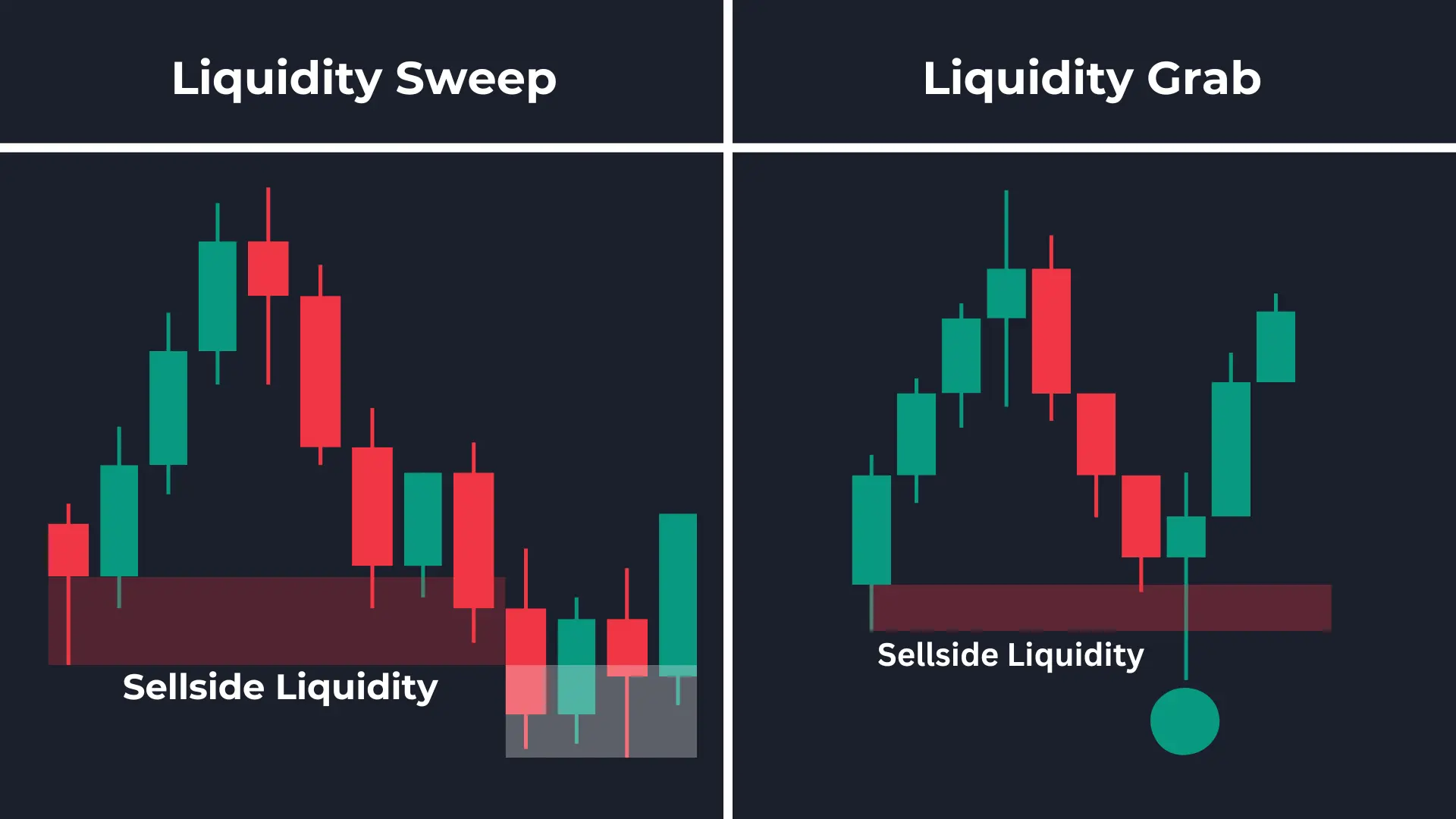Liquidity Sweep: Institutional Order Flow Analysis and Stop Hunt Detection

What is a Liquidity Sweep?
A liquidity sweep is a strategic price movement used by institutional traders (smart money) to deliberately push price through key levels where retail traders have placed pending orders, particularly stop losses. These market participants execute large orders to trigger clusters of pending buy or sell orders at specific liquidity zones, allowing them to enter or exit significant positions with minimal slippage.
The concept of liquidity sweeps is fundamental within the Smart Money Concept (SMC) framework, as it explains why markets often make sudden moves beyond significant levels only to quickly reverse. This phenomenon occurs because large market players need sufficient liquidity (other traders willing to take the opposite side of their trades) to execute their positions effectively.
After a liquidity sweep occurs and pending orders are triggered, the market typically reverses direction, often creating rapid price movements in the opposite direction. Understanding this dynamic provides traders with insight into institutional behavior and creates opportunities to trade alongside these powerful market participants rather than against them.
Understanding Liquidity in Trading
To comprehend liquidity sweeps, it's essential to first understand what liquidity means in trading. Liquidity refers to the ease with which an asset can be bought or sold without causing significant price changes. In the context of price action trading, liquidity often refers to areas where a high concentration of orders exists.
Types of Liquidity

There are two primary types of liquidity in trading markets:
- Buyside Liquidity (BSL) - This refers to levels on the chart where short sellers have their stop losses set, typically at swing highs or above resistance levels. When price reaches these levels, stop orders convert to market buy orders, providing liquidity for sellers.
- Sellside Liquidity (SSL) - This refers to levels where traders who are long have their stop losses set, typically at swing lows or below support levels. When price reaches these levels, stop orders convert to market sell orders, providing liquidity for buyers.
These liquidity zones are essentially areas where retail traders place their protective stops. Smart money participants target these zones deliberately to trigger these orders, creating the liquidity they need to execute their own larger positions.
Types of Liquidity Sweeps
Buyside Liquidity Sweep (Bearish)

A buyside liquidity sweep (also called a bull trap) occurs when:
- Price pushes above a swing high or resistance level where short sellers have placed their stop losses
- This triggers the short sellers' stop orders (converting them to market buy orders)
- It may also induce breakout traders to enter long positions, expecting higher prices
- After collecting this liquidity, price quickly reverses and moves back below the level
- This creates a bearish bias, as smart money has likely accumulated short positions and is now driving price lower
In this example, buyside liquidity is the key level to watch. Price shoots above this level, potentially consolidates briefly, and then comes back down below the level. This sweep of liquidity suggests traders should now have a bearish bias in the market and look for short trade opportunities.
Sellside Liquidity Sweep (Bullish)

A sellside liquidity sweep (also called a bear trap) occurs when:
- Price drops below a swing low or support level where long traders have placed their stop losses
- This triggers the long traders' stop orders (converting them to market sell orders)
- It may also induce breakout traders to enter short positions, expecting lower prices
- After collecting this liquidity, price quickly reverses and moves back above the level
- This creates a bullish bias, as smart money has likely accumulated long positions and is now driving price higher
In this example, sellside liquidity is the key level to watch. Price drops below this level, potentially consolidates briefly, and then comes back up above the level. This sweep of liquidity suggests traders should now have a bullish bias in the market and look for long trade opportunities.
How to Identify Liquidity Sweeps
Identifying liquidity sweeps involves recognizing where liquidity builds up and then observing how price interacts with these zones:
- Identify Key Liquidity Zones
- Mark previous swing highs and lows where traders are likely to place stop losses
- Look for equal highs and equal lows, as these areas often attract clusters of stops
- Pay attention to significant support and resistance levels
- Focus on areas with high trading volume, as these often contain more liquidity
- Watch for Price Interaction with These Zones
- Observe when price approaches and breaks through these levels
- Look for a decisive move beyond the identified zone
- Monitor for a subsequent reversal or deceleration in price movement
- Confirm the Sweep
- For a buyside sweep: Price breaks above a key high, then returns below that level
- For a sellside sweep: Price breaks below a key low, then returns above that level
- The more decisive the reversal, the stronger the confirmation of the sweep

Liquidity Sweep vs. Liquidity Grab
While related, liquidity sweeps and liquidity grabs have distinct characteristics:

- Liquidity Sweep
- Price moves beyond a liquidity level and may consolidate there for some time
- Eventually, price returns back through the level (whether immediately or after consolidation)
- This is a broader movement affecting a range of prices
- Liquidity Grab
- Occurs within a single candlestick
- Price quickly hits a level to trigger orders and immediately reverses
- Results in a candlestick with a large wick and small body (similar to a pin bar)
- Represents a more targeted, shorter-duration maneuver
While there are subtle differences between these two concepts, both indicate the same underlying market dynamic: smart money manipulating price to trigger retail trader stops before reversing the market.
How to Trade Liquidity Sweeps
Trading with liquidity sweeps involves these key steps:
1. Preparation: Identify Liquidity Zones
- Mark significant swing highs and lows on your chart
- Pay special attention to equal highs/lows and tight consolidations
- Identify major support and resistance levels where stops are likely to accumulate
- Use volume profile tools to see where the highest liquidity clusters exist
2. Wait for the Sweep and Confirmation
- Don't enter immediately when price breaks a high/low
- Wait for price to reverse back through the level (confirming the sweep)
- Look for a strong rejection candle pattern (engulfing, pin bar, etc.)
- The stronger the rejection, the more reliable the signal
3. Combine with Other Technical Elements
Liquidity sweeps are most effective when combined with:
- Order Blocks - Look for order blocks beyond the liquidity level for potential entries
- Fair Value Gaps - Sweeps often create or interact with fair value gaps
- Fibonacci Retracements - The 0.618-0.65 zone often provides confluence with sweep levels
- Market Structure - Consider whether the sweep confirms or changes the broader structure
4. Execute Trades with Clear Parameters
- Enter after confirmation of the sweep and reversal
- Place stops beyond the sweep zone (where the liquidity was taken)
- Target the next significant support/resistance level or previous swing point
- Consider a risk-to-reward ratio of at least 1:2 for most setups
Common Mistakes When Trading Liquidity Sweeps
Avoid these common pitfalls when trading liquidity sweeps:
- Entering Too Early - Jumping into trades before confirmation often results in being trapped in the sweep
- Ignoring Higher Timeframes - The most significant sweeps occur on higher timeframes (1H, 4H, Daily)
- Misidentifying Key Levels - Not all highs and lows contain significant liquidity; focus on the most significant ones
- Trading Sweeps in Isolation - Liquidity sweeps work best as confirmation signals, not standalone strategies
- Failing to Recognize Invalidation - If price closes and establishes beyond the sweep level, the pattern may be invalidated
Advanced Tips for Liquidity Sweep Trading
Enhance your liquidity sweep strategy with these advanced techniques:
- Multi-Timeframe Analysis - Identify sweeps on higher timeframes and use lower timeframes for precise entries
- Volume Confirmation - High volume during the sweep and decreasing volume during the reversal often confirms the pattern
- Market Session Awareness - Many liquidity sweeps occur around major session opens (London, New York) or during news events
- Repeated Sweeps - If price sweeps the same level multiple times, it increases the probability of a strong reversal when it finally occurs
- Divergence Confluence - Sweeps that occur with RSI or MACD divergence provide stronger trading signals
Conclusion
Liquidity sweeps provide valuable insight into institutional trading behavior and can help retail traders align with, rather than against, smart money flow. By understanding where liquidity builds up and how large market participants interact with these zones, traders can identify high-probability reversal points and potential trade opportunities.
Mastering the concept of liquidity sweeps requires practice and careful observation of market behavior. However, once integrated into your trading framework, they become a powerful tool for anticipating potential reversals and identifying optimal entry points aligned with institutional order flow.
Remember that while liquidity sweeps can significantly enhance your trading edge, they should be used as part of a comprehensive trading approach that includes proper risk management, market context analysis, and continuous learning.